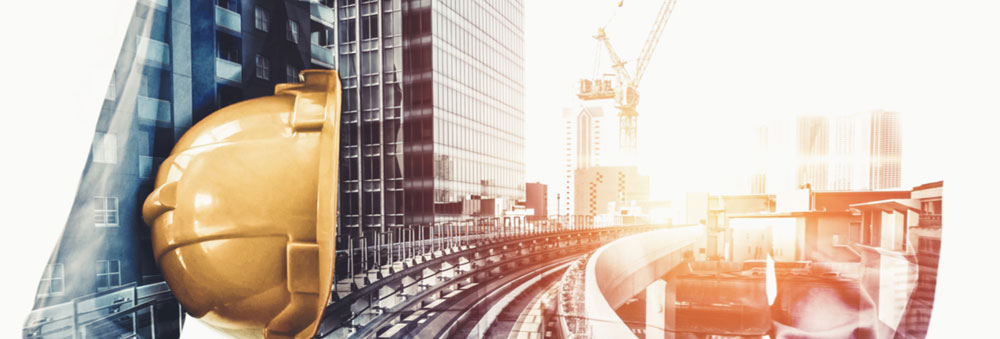Strategies for Strengthening Resilience in a VUCA World

The business environment can change overnight, presenting daunting, unanticipated challenges as well as genuine opportunities for those who have prepared for the unexpected.
Most of us have heard the term “the new normal” so many times that it has taken on the texture of a cliché, except that it’s not. For each of us as individuals and for the businesses that drive the global economy, this is no longer the same world we were living in a year ago. That includes construction, where the changes wrought by the coronavirus pandemic will be transformative and long-lasting. However, those changes need not be obstacles and may well present opportunities to businesses with strategies robust and flexible enough to manage the challenges ahead.
Indeed, the COVID-19 pandemic has driven changes that many of us have yet to fully understand and appreciate. It’s one of the greatest challenges most businesses and individuals will ever face, demanding sometimes painful adjustments. As history has shown time and again, global events like pandemics, global financial crises, international trade disruptions and widespread civil disorder can arise at the most inauspicious times, impacting business operations and throwing societies into disarray virtually overnight.
Some of you may have heard or read the acronym VUCA. It stands for volatility, uncertainty, complexity and ambiguity—a perfect description of the world we live in today. The term VUCA was coined in the 1990s by the U.S. Army War College to describe the dramatic changes and strategic challenges of the post-Cold War period.1 Since then, the term has been widely adopted by business leaders and strategists in many sectors to help emphasize the need for effective strategic planning. Understanding the forces described in the VUCA model can help organizations effectively execute the dual disciplines of crisis management and disaster recovery planning.
A 2018 article in Forbes2 categorized the key characteristics of the VUCA world as:
Volatility – The accelerating pace of change in an industry, market or the world in general. The faster the changes, the more unpredictable the world becomes.
Uncertainty – The extent to which we can confidently predict the future. The more uncertain the world is, the harder it is to predict with any degree of reliability.
Complexity – The more factors and the greater their variety, the greater the complexity that companies will experience in the business environment.
Ambiguity – A lack of clarity about how to interpret a situation, as when information is incomplete, contradictory or inaccurate.
Responding to the Unexpected
Many would argue that we’ve always operated in a VUCA world; it is simply the challenge of doing business in a perpetually changing environment. True enough. At almost any time, an organization can be affected by events with widespread, even global, consequences. Some, like natural disasters, can be insured against, while others cannot. But the timing and impacts of major events, a perfect example being the coronavirus pandemic, are difficult to predict.
The immediate effects of the pandemic on the design, engineering and construction industries were the temporary shutdowns of many projects in hard-hit regions of the U.S., a difficult proposition in a cash flow-intensive business such as construction. However, as the daily peaks of confirmed coronavirus cases subsided in some heavily impacted regions, we have seen the rapid resumption of many projects. Additionally, a number of those considered “essential” never did completely shut down.
Looking ahead, the industry will likely experience significant growth in public spending as both sides of the political aisle find common ground on the need to rebuild critical U.S. infrastructure. Additionally, many companies will be called upon to perform work required by corporations as they reconfigure their facilities to contend with a future in which the coronavirus may always be a part of the environment. However, the construction industry, like all other business and industry segments, will need to adjust operations to align with the new normal imposed by the outbreak.
Construction professionals are accustomed to the need for robust site safety practices, including a wide variety of personal protective equipment (PPE) and tools. Face masks and shields are common on most job sites for everything from welding, protection against harmful dust associated with various abrasives, to the potential inhalation of dangerous vapors released by volatile chemicals. That being the case, it is not a stretch to extend the usage of PPEs to help protect against infection by the coronavirus. In addition, new wearables and apps to help combat the transmission of COVID-19 will be coming online to gather data about markers such as employee temperatures and to assist in maintaining appropriate physical distancing.
Strategies for Resilience in an Uncertain World
The Harvard Business Review3 has addressed the strategic challenges of driving sustainability in a VUCA world, offering the following recommendations:
- Manage volatility. Build in slack and devote resources to preparedness. Examples would be to stockpile inventory or overbuy talent. These steps can be expensive, so the investment should align with the perceived risk.
- Navigate uncertainty. Invest in information; collect, interpret and share it. This works best in conjunction with structural changes, such as adding information analysis networks to help reduce uncertainty.
- Reduce complexity. Restructure where required, bring on or develop specialists, and build up resources adequate to address the degree of complexity within your organization.
- Clarify ambiguity. Experiment; understand that cause and effect require generating hypotheses and testing them. Design your experiments so that lessons learned can be applied broadly.
Insights for Navigating a VUCA Environment
Over the years, FMI has spoken with a wide range of individuals—from executive coaches to senior consultants and numerous executives from design and construction companies—to gain valuable insights into how to successfully manage and respond to the challenges of this VUCA environment. The discussions revealed five areas that strategic thinkers in the design and construction environment share in their approach to an increasingly uncertain world.
-
Anticipate and prepare for the unexpected.
Good business intelligence promotes faster, more effective decision-making and can make the difference between seizing an opportunity or being left behind. Company leaders must develop a deep understanding of the strategic “ecosystems” within their organizations and how they relate to the wider industry. They must also stay on top of competition; owner behavior; political, economic and regulatory drivers; and other forces interacting with each other. Executive mandates should center on developing “eyes and ears” that span geographies, industries and businesses, with a specific focus on understanding customer and competitor behavior.
-
Collaborate and test new ideas.
Company leaders consume a vast amount of data and information, which can leave them feeling overwhelmed and paralyzed in decision-making. This makes it particularly important for leaders to engage in collaborative dialogue with peers to test and confirm ideas and check assumptions about evolving risks and their potential impacts. Going it alone in decision-making in this increasingly volatile world may be a recipe for disaster. Building consensus across a leadership team will help ensure broader buy-in and support for important strategic decisions and more “skin in the game” in sharing outcomes and the need for course changes.
-
Adopt and strengthen critical-thinking practices.
Leaders who qualify as critical thinkers question their beliefs and assumptions, and continuously ask themselves what might be done differently to respond to a volatile and unpredictable business environment. This mindset should not devolve into “paralysis by analysis,” but rather provide leaders with opportunities to self-correct and monitor their lines of thinking in an environment of changing information and conditions. Critical thinkers are open to new ideas and are willing to challenge their beliefs and investigate contrasting opinions.
-
Commit to continuous learning.
A passion for lifelong learning is an essential characteristic for any successful business leader. Truly strategic thinkers actively seek new perspectives about organizational problems and potential solutions. And leaders attuned to the realities of a VUCA environment recognize that continuous learning will be critical to long-term organizational agility, creativity and resilience. A combination of training, mentoring and executive coaching can help such leaders stay on lifelong learning tracks. Some have even recommended that leaders form “personal boards of directors” comprised of peers, external experts, company employees and even friends and family members with whom a strategic decision-maker might consult and share ideas before arriving at a course of action for a particular issue or problem.
-
Become an agile thinker, while remaining focused on the horizon.
Agile thinkers will necessarily maintain a high degree of vigilance toward changing events in the world around them, while at the same time maintaining a clear focus on internal goals. This dual perspective can help organizations achieve key performance markers with greater consistency over time, while enabling leaders to more effectively anticipate externalities that might impact the attainment of those markers now or in the future.
Control What You Can Control
While all of us hope that the pandemic will be short-lived, we can be sure that this will not be the last major event likely to disrupt global society and commerce. To say that there is nothing we can do about these events is fundamentally wrong. While we cannot predict, we can prepare for what may be ahead with a focus on controlling what we can control. That is the responsibility, and opportunity, of prudent and farsighted managers in construction and all other business disciplines. And it is the essential truth of living and working in a VUCA world.
1 Forsythe, George (Brig. Gen.); Kuhla, Karen; Rice, Daniel. “Understanding the Challenges of a VUCA Environment.” Chief Executive. 15 May 2018.
2 Kraaijenbrink, Jeroen. “What Does VUCA Really Mean?” Forbes. 19 December 2018
3 Bennett, Nathan; Lemoine, G. James. “What VUCA Really Means to You.” Harvard Business Review. January-February 2014. Insights for Navigating a VUCA

Michael A. Davis, RPLU, is the Head of Construction Professional Liability for U.S. Commercial Insurance at Zurich North America. He works with brokers, customers and Zurich team members across multiple functions to deliver effective products and services, including risk insights. In addition to Construction professional liability underwriters and underwriting assistants, he is supported by Zurich Construction’s regional teams, Risk Engineers, dedicated Claims staff and many other colleagues.
Prior to his current role, Davis was responsible for professional and pollution liability for architects, engineers and environmental services firms for the Environmental business group, including coordination of placements for large, multinational service firms.
Before joining Zurich, he worked for Kemper Insurance, building and leading the Construction and Consulting division of Kemper Environmental. Prior to that, Davis held underwriting, product management and risk consulting roles for Environmental Compliance Services. Prior to starting his insurance career, he worked as a professional geologist, directing field services for a regional geotechnical and geologic consulting firm.
Davis graduated from LaSalle University with a Bachelor of Arts in Geology and studied Engineering Geology at Drexel University. He holds a Registered Professional Liability Underwriter designation. He can be contacted at [email protected].

.png)

